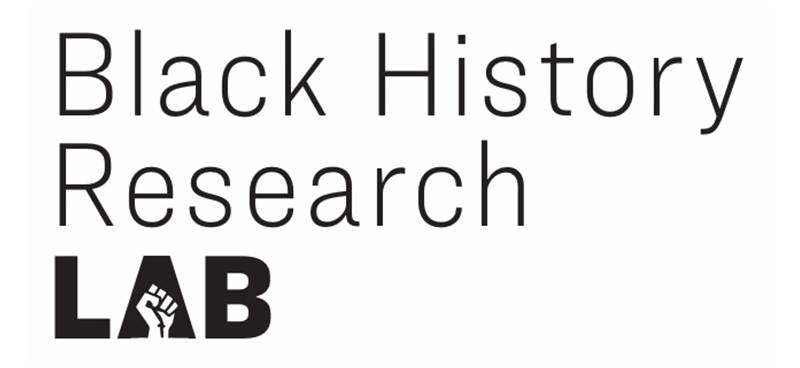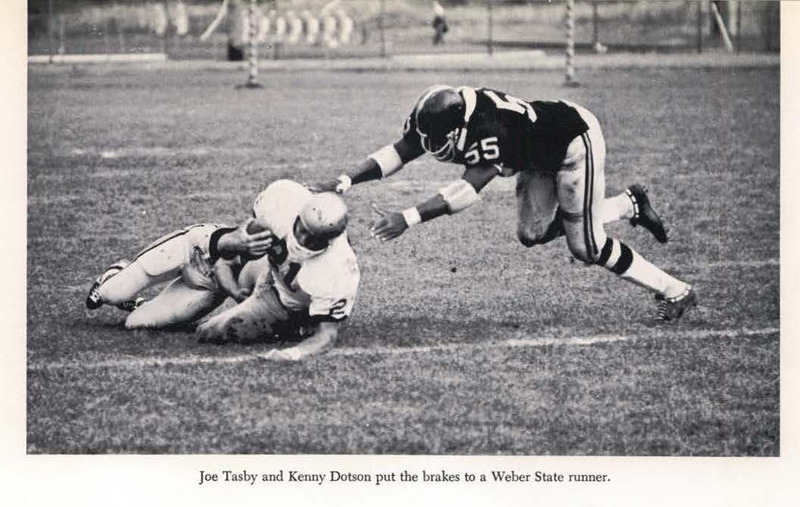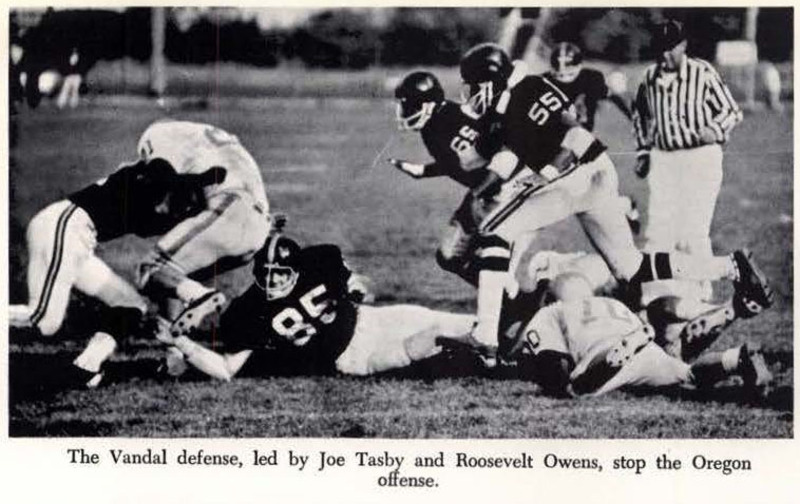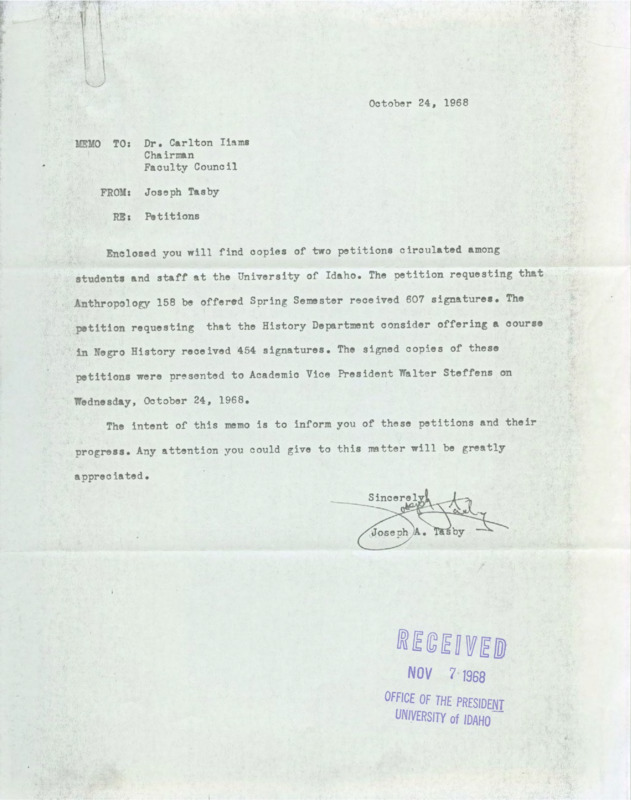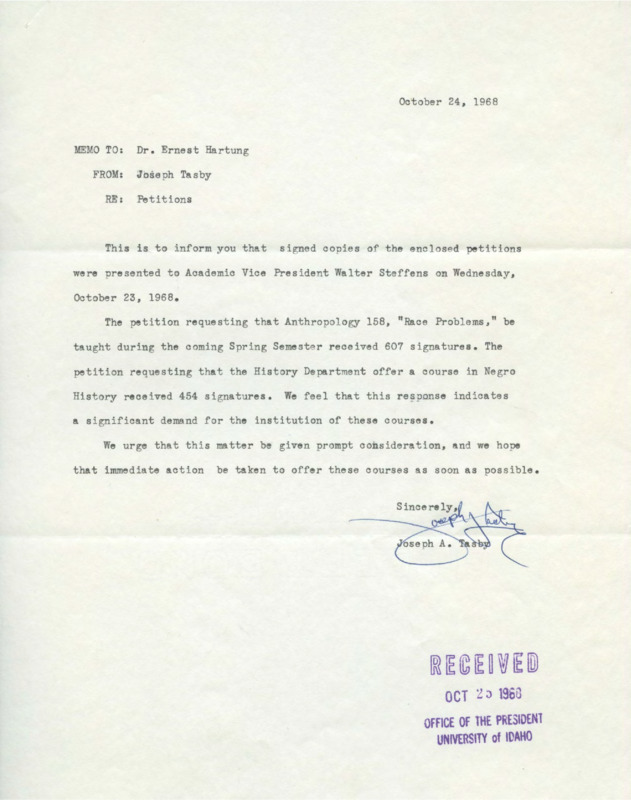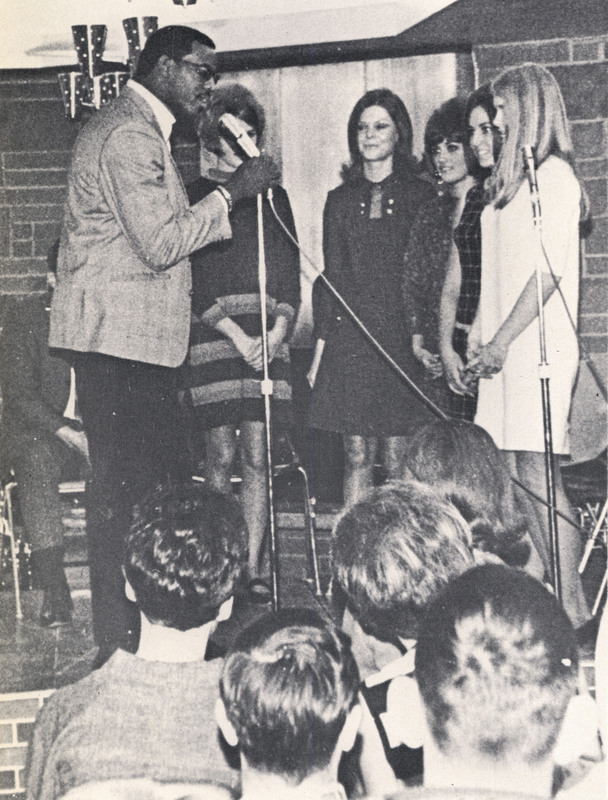Joseph Tasby
by Brody Gasper
Joseph (Joe) A. Tasby Jr. was originally from Houston, Texas, where he attended Evan Edward Worthing High School, a school that was still segregated at his time of graduation in 1966.1 During his high school football career, he was a four-year letterman and an All-State selection during his senior year. He accepted a football scholarship from the University of Idaho and enrolled at the University in 1967, which helped him get away from hardships at home.
Even with his past experiences in Houston, Tasby noticed that there was more prejudice in Idaho, not in sports but in the social acceptance of Blacks. In an Argonaut article from 1968 by Laura Lorton, Tasby says, “We (the Negroes) are accepted totally in sports…On the cinders, the hardwood, or the football field, we’re all a part of the Vandal family. But we desire social acceptance also.”2 He includes the example of Idaho coeds refusing to date or dance with Black students for fear of hurting their reputations: “I have had young ladies living in Greek houses tell me, to my face, that they cannot risk their sorority standing by being associated with me because I am black.” 3 After experiencing racism at the University of Idaho, Tasby saw a need to educate the students on campus.
Tasby became significantly more involved in the school’s political atmosphere in 1968 and started writing a regular column for the Argonaut titled “The Darker Side,” that covered race issues at the University. His engagement in political activism on campus was met with disapproval and little support as indicated in letters responding to his writing.
One reader of the Argonaut commented negatively with bigoted and racist remarks, targeting not only Tasby but the “Black Man” in general: “Joe, I’m acquainted with three of ‘The Boys,’ Mr. Grosvenor, Mr. Brown, and Mr. Wheeler (Black male students). If the Negro race had more sensible people as these, there wouldn’t be a repeat of Harlem or Chicago. I also admire you, Joe, for using your brain rather than your muscle. I can see hope for the Black Man.” 4 The reader also includes the fact that both of his parents had been active members of the Ku Klux Klan for three years. This note depicts a part of the racial tensions and atmosphere at the University of Idaho in 1968, an environment that was not all too keen for the “Black Man” to have a voice on campus.
Despite this backlash and others, Tasby continued to pursue his political and academic goals on campus, with his most prominent being the establishment of a Black History course. On October 23rd of the same year, Tasby put together several petitions for the implementation of Anthropology 158: “Race Problems” and the first-of-its-kind Black History course at the University of Idaho. The petitions were sent to Dr. Carlton Iiams5, Academic Vice President Walter Steffens, and President Ernest Hartung,6 which were then circulated within both the History Department and the Faculty council.
Although the petitions collected a number of signatures that were small in comparison with the overall size of the student population at the time, the number of signatures showed the faculty that there was interest in the subjects.7 These petitions would sit on the docket in the History department meeting minutes for some time, with Drs. Rolland Siegfried and Willard Barnes taking the lead on implementing the Black History course, and creating an actual proposal for the course in 1969 and an updated version in 1970.8
The course, titled the “Negro in America” history course, was implemented for the 1970-1971 school year under the direction of Drs. Siegfried and Barnes. What Tasby had fought hard for was now a reality, the University of Idaho would have its very first Black History course thanks to him. The implementation of these courses threw the University of Idaho almost into a new era, one which would pave the way for greater inclusivity with Black students and faculty.
Tasby is one of the first of many Black student athletes to make an actual change at the University. During his time as a linebacker on the 1968’s Vandal football team, he made 25% of the tackles.9 Several pictures of his playtime appear in the Gem of the Mountain Yearbooks, specifically during 1968, which appears to have been his best.10 He was a football player that scouts had an eye out for. However, due to a knee injury during Tasby’s senior year, he was not drafted into the NFL.11
After graduating from the University of Idaho with his Bachelor of Science in Education, Tasby moved on to the Massachusetts Institute of Technology (MIT) where he received his master’s degree.12 He served as a substitute teacher for the Pearland Independent School District and is currently working as a Life Coach at his own company (J. Tasby Inc) in Houston.
Joe Tasby had a significant impact on the University of Idaho, being one of the forces directly responsible for the implementation of the University’s first Black History course as well as helping to educate the students on campus during his time at the school. Tasby is certainly an example of what student activism can accomplish and his story serves as inspiration for the current generation of students at the University of Idaho today.
Notes
- “Obituaries: Whaylon Coleman Sr.,” Messenger-Inquirer (Owensboro, KY), Apr. 29, 2012.
-
Laura Lorton, “Judge Me First as a Man Says U - I Footballer Tasby,” Argonaut, February 2, 1968, The Argonaut Digital Collection. ↩
-
Ibid. ↩
-
Ibid. ↩
-
“To the Editor,” Argonaut, November 22, 1968, The Argonaut Digital Collection. ↩
-
“Memorandum regarding petitions for “Negro History” course,” Black History at the University of Idaho. ↩
-
“Memorandum regarding petitions for two new courses,” Black History at the University of Idaho. ↩
-
“Memorandum regarding petitions for “Negro History” course.”Black History at the University of Idaho. ↩
-
“Correspondence regarding “Proposal for a course to be entitled ‘The Negro in American History’,” Black History at the University of Idaho. ↩
-
“The Big Ones Scouts are Watching; Here are Five Sparkling Sophomores, and the 90 College Players that the Pros Rank as the Best,” Sports Illustrated, Sept. 11, 1967. ↩
-
University of Idaho, 1968 Gem of the Mountains, (Vol. 66 pp. 177-178), Gem of the Mountains Digital Yearbook Collection, accessed July 3, 2022. ↩
-
Xtreme Heat Sports TV, “I AM Podcast - Season 1- Episode 8 Special Edition - Joseph Tasby”, August 4, 2020. ↩
-
“Joseph Tasby” LinkedIn, accessed July 3, 2022. ↩
